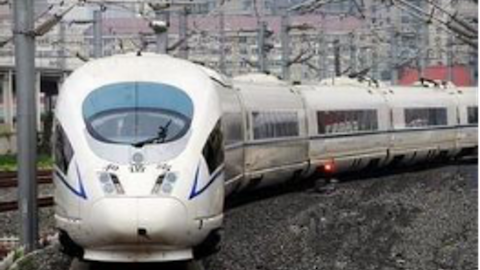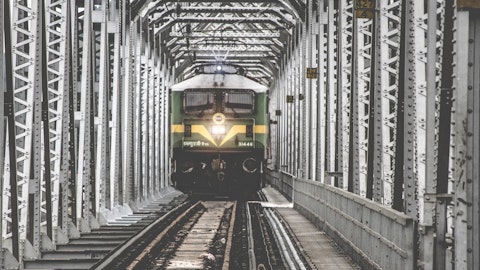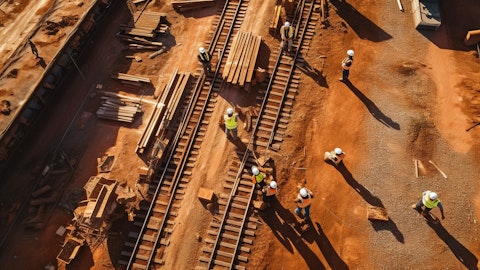Angel Castillo: Very helpful. Thank you.
Operator: And our next question today comes from Saree Boroditsky with Jefferies. Please go ahead.
Saree Boroditsky: Thanks for fitting me in. So, you announced the $1 billion in share buyback authorization. Can you just talk about how you’re thinking about using the cash flow this year between repurchases and M&A, the expected timeline for completing this authorization, and if any of this baked into your EPS guidance for the year?
John Olin: So, Saree, number one is in terms of capital allocation, we are on track to do what we’ve done in 2023. Again, we couldn’t be more pleased with the balance that we had in 2023 when you look at the free cash of about $900 million, operating cash of $1.2 billion, it would sound pretty split between M&A and share repurchases. When we look forward, as you know, we will prioritize M&A over share repurchases as long as we have good strategic bolt-on M&A. And if not, we will return excess cash to our shareholders in the form of share repurchases. In relationship to the authorization, it replaced the old authorization that we had. So, we’ve got the ability to spend up to a $1 billion in share repurchases. And again, that will be determined throughout the year as far as what we have in M&A opportunities.
Saree Boroditsky: But is it fair to say that any of that — any additional share buybacks this year is not included in your EPS guidance?
John Olin: Our guidance includes all of our business aspects as well as the use of cash in 2024.
Saree Boroditsky: Okay. So, it does include share buybacks?
John Olin: Share buybacks, M&A, or the use of that cash, yes.
Saree Boroditsky: Okay. And then, for next question, I know you’re hesitant to kind of put a number on Freight margin performance for this year, but maybe comment on incremental margins in Freight, because I think you should have easier comps with the absence of the strike, you have higher volumes, and you’re exiting lower-margin products. So, what can we think about for incremental Freight margins this year?
John Olin: Well, overall, you can figure out where we’re — what we’re looking at for incremental margins on a company in total. Freight will certainly be a driver of that, but we also expect margin growth in the Transit side. When you look at, we are lapping some impact to the strike that we had, and that’s been incorporated in our overall guidance, right? So, when we look at the margins in general, we’re looking at favorable productivity and absorption, and certainly, the benefits of Integration 2.0 as well as portfolio optimization that you mentioned. Now, again, there’s going to be some headwinds to that on unfavorable mix.
Saree Boroditsky: Great. Thanks for taking my question.
John Olin: Thank you.
Operator: And our next question today comes from Chris Wetherbee with Citigroup. Please go ahead.
Unidentified Analyst: Hey, thank you, operator, and good morning, everyone. This is Rob on for Chris. If I could dig a little bit further into Integration 2.0, it looks like on a run-rate basis, exiting 2024, more than double the savings. Can you give us a sense of the cadence you’re expecting to realize that run rate throughout ’24?
John Olin: Yeah. We wouldn’t expect any unusual aspect of that. There’s numerous projects that make up Integration 2.0, and most of them have all been executed. And now it is just different levels as the savings start to drive forward. So, for purposes of modeling, probably more straight line is more accurate than any other way to look at them, that build.
Unidentified Analyst: That’s really helpful. And then just to kind of circle back on Justin’s question about the cadence of earnings and revenue growth, can you give us any — can you fine-tune kind of the percentage of revenue you are expecting in the first half versus the second half? Clearly, it’s going to be more weighted to the first half, but…
John Olin: Yeah, we would just expect revenue growth to be higher in the first half than in the second half, again, largely how we have some of our delivery of the high-ticket items planned. But, again, whenever you move a few locomotives from one period to the other, or deliveries a little bit ahead or behind, it’s hard to get too fine-tuned on that. So, suffice to say that the first-half revenue growth will be a little bit higher than the second half.
Unidentified Analyst: Understood. Appreciate the color.
Operator: Thank you. And our next question comes from Bascome Majors with Susquehanna. Please go ahead.
Bascome Majors: You talked about a roughly neutral volume environment for North American rail. How much would that have to deteriorate to start to meaningfully impact your service revenue on the locomotive contracts?
Rafael Santana: So, what we described was carloads being, I’ll call it, to some extent muted for the year. That has, of course, been included into our guidance. What I think you have that more than offsets this is the continued opportunity here for customers to really invest for returns, it’s really by driving productivity, lowering costs, replacing, in some cases, three units for two units, and I think those dynamics remain in place and remain in place not just for ’24 as you see reflected here by the orders that we just got. We think, at least from a fleet perspective and parkings, service levels have really — the focus on service levels has really kept the active fleets relatively stable, and we would expect us to continue to be — have a favorable market dynamics for North America included.
Bascome Majors: And moving to international, on the buyout in Kazakhstan, you talked about not much 2024 impact from that. As you look out longer term, is the deal structured in a way where all of the benefits from any of this $2 billion-plus of MOUs converting to orders would accrue to Wabtec? And just longer term, when could that become a meaningful contributor to your overall profit profile? Thank you.
John Olin: Bascome, I would think about the LKZ venture that we have as an assembly joint venture. So, it doesn’t have any impact on our overall revenue growth or growth into the CIS region. What it does is it improves our supply chain, right? A lot of the things that we were driving through the joint venture were kits that we would make and lot of the parts were made in other parts of the world and shipped in there, and the JV was for the assembly side of it. So now, this just gives us a great operational — complete control over the operational supply chain in an area of the world that we believe is going to show significant growth going forward.
Rafael Santana: We have significant growth in ’24, we have significant growth in ’25, and we have an opportunity here to utilize that installed — that manufacturing footprint to export outside of Kazakhstan, and I think that’s a significant element here. On the top of this, just had some really strong returns for us.
Bascome Majors: Thank you.
Operator: Thank you. And our next question comes from Steve Barger with KeyBanc Capital Markets. Please go ahead.
Steve Barger: Hey. Thanks. John, you said equipment will be the fastest growing group, but if I’m remembering right, that category is pretty evenly split between locomotive and mining, marine, and drilling. Are you thinking locomotive outgrows the industrial products, or do you expect more equal growth from those kind of two categories?
John Olin: Yeah. We don’t break it out specifically, Steve, but when we look at 2024, our equipment group, we expect good growth out of both locomotives as well as mining equipment.
Steve Barger: Got it. Thanks. So, similar growth rates, no big variance between the two?
Rafael Santana: Steve, it’s, I think, a challenge here. Might have, again, variation as we go through it, but they’re strong. They’re strong, both strong, and a lot of it really internationally driven and beyond ’24.
Steve Barger: Got it. And for Transit, you’re coming off a tough comp, but really the best growth in years. And with equipment and services on the Freight side outgrowing consolidated guidance, does that mean Freight is more like high-single digit for the year and Transit low-single digit?
Rafael Santana: We won’t get into the specifics or guiding for Transit or for Freight. What I’ll tell you, on Transit, the fundamentals for the business continue to be strong, book-to-bill ratio closed over 1 for the year. While we are pleased with the progress, we continue to do significant work here to simplify the footprint. This business will deliver on margin expansion in ’24. Integration 2.0 is a significant contributor to that. But we will continue to have variation quarter-to-quarter, driven by really mix and timing of project.
Steve Barger: Understood. Thanks.
Rafael Santana: Thank you.
Operator: Ladies and gentlemen, this concludes our question-and-answer session. I’d like to turn the conference back over to Kristine Kubacki for any closing remarks.
Kristine Kubacki: Thank you, Rocco, and thank you, everyone, for your participation today. We look forward to speaking with you next quarter.
Operator: Thank you. This concludes today’s conference call. We thank you all for attending today’s presentation. You may now disconnect your lines, and have a wonderful day.
Follow Westinghouse Air Brake Technologies Corp (NYSE:WAB)
Follow Westinghouse Air Brake Technologies Corp (NYSE:WAB)
Receive real-time insider trading and news alerts



